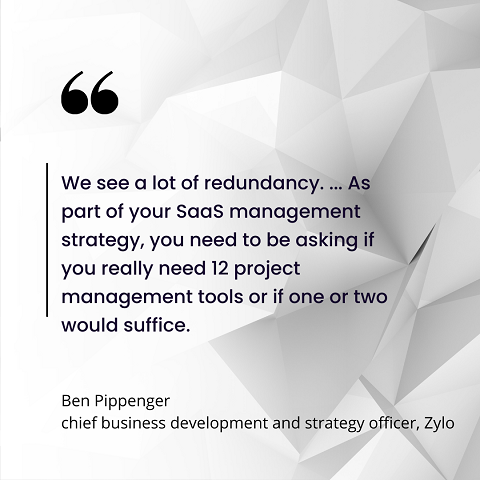Underutilized SaaS Apps Costing Businesses Millions
SaaS investments continue to grow despite organizations utilizing only half of their SaaS licenses, a new report finds.
April 26, 2023

Organizations are wasting more $17 million on unused or redundant software-as-a-service (SaaS) applications each year, with enterprise organizations spending more than $224 million on SaaS but only utilizing half of their SaaS licenses.
These were among the results of Zylo's SaaS Management Index report, which found that 70% of SaaS application contracts were renewed in 2023, despite being underutilized.
The findings also indicated SaaS investments continue to grow, with the average organization adding six new apps to its tech stack every month.
The 'Great Rationalization'
Ben Pippenger, co-founder and chief business development and strategy officer at Zylo, said organizations are turning to their software stack as a place to find cost savings.
"We're calling this the 'Great Rationalization,' as we're seeing more companies adopt this behavior and take stock of the software they have and make data-driven decisions about what they actually need," he said.

Pippenger-Zylo
Organizations have been transitioning to SaaS, or cloud-based software, for years now, but there was a massive uptick in SaaS investments in 2020 during the onset of the COVID-19 pandemic, when organizations had to mitigate the challenges of remote and hybrid workforces, according to Pippenger.
"Now that we're arguably post-pandemic, many companies still recognize the value of cloud-based software to keep their teams productive and connected," he said. "You get access to the latest updates and new features, which means you have direct access to new innovations and so much more."
Why SaaS Management Is a Group Effort
Managing a SaaS portfolio is truly a team sport and requires stakeholders from across the organization — but specifically IT and finance teams are most directly involved, driving the charge, Pippenger said.
"For both of these teams, having a complete picture of all SaaS applications in use is crucial," he said. "It provides IT the information they need to mitigate risks, strengthen the organization's security posture, and maximize adoption."
Improved visibility provides finance teams with the information they need to properly forecast and budget for software in the future and identify opportunities for cost savings.
"Both of these groups need to partner with business units and employees who are purchasing software to understand use cases, ensure that the software being purchased is necessary, and align to the organization's holistic application strategy," he said.
Reducing Software Bloat
To better assess the use level of SaaS apps and decide how to reduce bloat, Pippenger puts it simply: Use the software you pay for; pay for the software you use.
"To do this, you must understand your software's utilization" he said. "How many licenses are you entitled per your contract, and how many of those are being used in a 30-, 60-, or 90-day period?"
For context, the survey found the average organization uses just 56% of their SaaS licenses, which means the remaining 44% are wasted.
"Once you can answer that question, it becomes possible to cut out waste with laser precision because you can see where bloat exists," Pippenger said. "Once you've identified who is no longer using those software license, you can downgrade those users to a more appropriate license type or deprovision that license."
Another proven method to reduce software bloat is to rationalize the SaaS portfolio, Pippenger said.
"We see a lot of redundancy, especially in categories like online training, team collaboration, project management, file storage and sharing," he said. "As part of your SaaS management strategy, you need to be asking if you really need 12 project management tools or if one or two would suffice."
On an ongoing basis, organizations should also establish proper governance of their SaaS estate.
Pippenger said he sees this manifest in many ways — from enacting specific policies on who can purchase software and how it can be purchased to the establishment of software steering committees that review new purchases or renewals of software of a certain size.
"Whatever this looks like in practice, the central purpose is the same: to establish some guardrails that protect the organization from security and budget risks," he said.
About the Author(s)
You May Also Like


.jpg?width=700&auto=webp&quality=80&disable=upscale)


_(1).png?width=700&auto=webp&quality=80&disable=upscale)

.png?width=700&auto=webp&quality=80&disable=upscale)